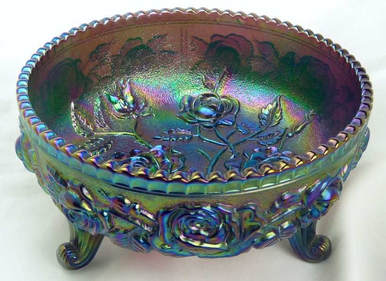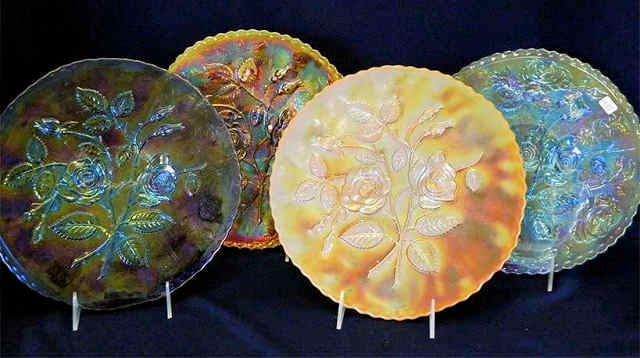A Rose By Any Other Name - Imperial's American Beauty Roses
Copyright G & S Thistlewood
|
Imperial’s rose pattern was introduced around 1911 or 1912. Known to collectors today as Open Rose and Lustre Rose, these items are often confused with each other. Which is which? Does it matter? The truth is that they are both part of the same pattern range that was originally called “American Beauties” or “American Beauty Roses” by Imperial. All shapes in the pattern belong to the same design suite. Note that both names (“American Beauties” and “American Beauty Roses”) were used in the catalogue extract shown below, but the term “American Beauties” appeared consistently throughout "Catalog 101B" issued in 1915, and was probably the name actually given to the pattern range. There was one reference to a “rose pattern” for the 9 inch plate, which oddly, wasn’t called “American Beauty”. It’s also interesting to note that Imperial drew attention to the use of patterns on both the interior and exterior of the pieces. Of course, that was a practice used by all the Classic Carnival makers - but Imperial clearly didn’t want to miss a selling point. There are subtle variations in the pattern, for example between the footed and the collar based bowls, and also according to size. Some of these variations are illustrated in the Imperial catalogue extracts shown below. |
Above: an Imperial Open Rose 9 inch plate in purple.
|
Above: Illustrations from Imperial’s "Catalog 101B" (1915) featuring “Iridescent Novelties”.
Above: Illustrations from the Imperial Bargain Book, Second Ed. c. 1924. The footed bowl on the left shows the double drapery columns
between the rose designs, and on the right is the design shown on the 9 inch collar based bowl. Both images are courtesy of Jon D Bartell.
between the rose designs, and on the right is the design shown on the 9 inch collar based bowl. Both images are courtesy of Jon D Bartell.
So how did one basic rose pattern get two names?
Back in the 1960s, Marion Hartung classed the Imperial rose pattern that features two open roses and four buds as Open Rose. She gave the name of Lustre Rose to all other pieces: water and table sets, and bowls that feature “four large flowers in high relief and six buds”. Mrs Hartung further observed that on the Lustre Rose bowls, “the background is stippled and ends in a saw tooth edge outlined by three raised lines”. You can see this “saw tooth edge” etc., on the pieces in the catalogue ad shown on the previous page.
The easy way to differentiate between the two variations of the rose pattern is that collar based bowls and plates are what we call Open Rose, and other shapes (footed, water and table sets) are Lustre Rose. The simple fact is that Imperial intended them to be all part of the same general pattern.
|
A Lustre Rose centrepiece bowl in smoke.
Courtesy Seek Auctions. |
If only we’d had access to the catalogues fifty years ago, there’d be less confusion now, as we could call all the shapes, quite simply … American Beauties. Fully twenty two different shapes and sizes of the “American Beauties” were illustrated in the section of catalogue 101B. The low, footed bowl shown on the left is usually referred to as a centrepiece bowl today, but in fact it was originally intended as a low salad bowl, as the extract from the Imperial catalogue 101B (below) shows. The splendid bowl illustrated on the left is in smoke. Imperial’s "Catalog 101B" (1915) featuring “American Beauties”.
|
The Imperial rose pattern was given the number 489 in the catalogues that were subsequent to the 1915 "Catalogue 101B". Note that the reference numbers for ordering were quite different in these illustrations from 101B.
As you can see in the image above, the colours indicated in catalogue 101B were Rubigold, Azur, Helios and Old Gold. Rubigold and Helios are understood and known today as marigold and helios (green with silver-gold iridescence); Azur is purple and Old Gold is amber. This only scratches the surface of the range of colours that this pattern is known in: blue, smoke, vaseline, aqua, lavender, clambroth, lime, powder blue, olive, amberina and red are all reported.
|
Shown below is a blue fernery with purple, blue and green iridescence in old Classic Carnival. Blue Imperial is usually very rare, although the fernery shape seemed to be used more frequently for this colour. On the right is an Imperial catalogue illustration which called it a salad dish or fern dish: multi-purpose use meant more sales. A Lustre Rose fernery in blue.
|
A long-running and very popular pattern.
|
On the left is a 1912 Butler Brothers wholesale ad for Imperial’s Glassware Assortment which included five different shapes in their rose pattern - a ruffled bowl, two shapes of a deep round bowl, a rosebowl and a plate. They were all offered in either "Golden Beauty" (marigold) or "Silver Beauty" ("Silvered-green, namely helios).
The other patterns / shapes in the assortment were Pansy (bowl, sugar and creamer) and a Ripple vase. Note how there were 12 shapes listed in the ad, but only 9 were illustrated, giving the wholesaler some "flexibility" in what pieces were actually packed in the barrel. Shown below is another Butler Brothers ad: it's from 1929, showing that the pattern was still going strong almost twenty years after its inception. |
|
Contemporary Production
Imperial and its later incarnations (with Lennox and Arthur Lorch) reissued some shapes in the Open Rose / Lustre Rose / American Beauties pattern, referring to the pattern as Imperial Rose. They were marked with either IG, LIG or ALIG. The large chop plate (measuring around 10.5 to 11 inches) was only made as a Contemporary shape, as that large size was not produced in Classic Carnival (the Classic Carnival plates were 9 inch). On the right are several chop plates, all marked IG, in ice blue, marigold, smoke, and marigold on milk glass. The pattern was reproduced in Contemporary Carnival by Fenton (and marked Fenton) and by L E Smith (marked with an ' S '). It was also reproduced in the water and table set shapes (and possibly also a bowl) by Summit Art Glass. A letter V (for Vogelsong, the owner of Summit) was often added close to the Imperial trade mark. |
Above: Contemporary Imperial Rose pieces.
Left to right - a ruffled bowl in white, a chop plate in smoke and a creamer and sugar set in deep blue (IG marked). All courtesy of Seeck Auctions.
Left to right - a ruffled bowl in white, a chop plate in smoke and a creamer and sugar set in deep blue (IG marked). All courtesy of Seeck Auctions.
Not forgetting Riihimaki, Finland!
Riihimaki made a "look-alike" pattern that is a copy of (but not identical to) Imperial's Open Rose. It is so much like the Imperial original that we named it Riihimaki Open Rose. Just two examples of the Carnival Riihimäki Open Rose plate are currently reported, and this small 6 inch plate is so far, the only known shape to be found in Carnival Glass: it is a very scarce item.
Riihimaki made a "look-alike" pattern that is a copy of (but not identical to) Imperial's Open Rose. It is so much like the Imperial original that we named it Riihimaki Open Rose. Just two examples of the Carnival Riihimäki Open Rose plate are currently reported, and this small 6 inch plate is so far, the only known shape to be found in Carnival Glass: it is a very scarce item.
|
Riihimaki Open Rose has a pale pink coloured base glass with marigold iridescence - it is shown on the immediate right, with the original Imperial Open Rose on the far right, for comparison. Just as with Imperial's original, the Riihimaki version has an interior pattern of two, long stemmed, open roses, encircled with leaves and rosebuds. There are many small differences in the design of the interior rose pattern when compared with Imperial's. The exterior design is also similar - as with Imperial's version, Riihimaki Open Rose has panels divided by double lines, each panel showing an open rose with buds and leaves. Imperial's Open Rose has three panels showing a rose with buds, alternating with three smaller panels that feature a daisy motif. However, Riihimäki's version has four large panels, each featuring a rose and buds: there is no daisy motif. The Riihimaki version also has a ground base. We found the pattern illustrated in the Riihimäki 1939 catalogue, where the plate is shown as #6232 laakea (flat) and #6233 syvä (sloping sides). A bowl is shown with three slightly different profiles, #7321 (flared), #7323 (rim turned out) and #7324 (cupped in). Only the 6 inch plate is so far known in Carnival. |


















